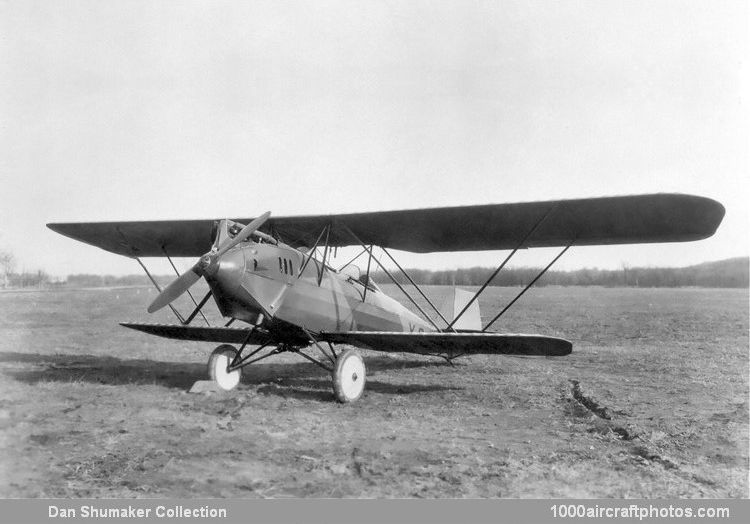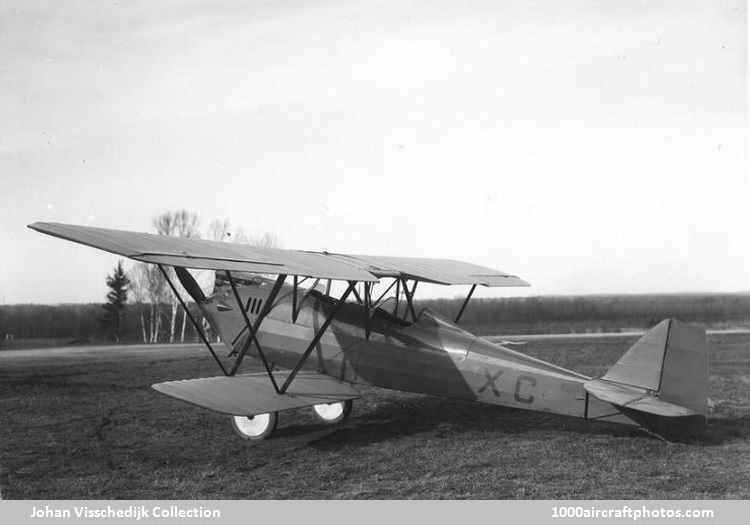12/29/2014. Remarks by Johan Visschedijk: "In February 1928, the Englishman Wilfried Thomas Reid left Canadian Vickers' engineering department and set up his own company, the Reid Aircraft Company Ltd., and he was joined by Martin J. Berlyn, also from Canadian Vickers. They set up an office on Craig Street in Montreal, Quebec, Canada and began the design of a two-seat light aircraft for flying clubs, commercial training schools and private owners. Construction was soon started in a hangar at Cartierville, Montreal.
The aircraft was the Rambler, a sesquiplane with folding wings for economic storage and incorporated Warren truss bracing which eliminated all bracing wires. The interplane struts were of streamline tube, but the prototype in its original form had circular-section tube struts with wooden fairings. A balanced rudder with no fin and skewed, or inversely tapered, ailerons were fitted. Longitudinal trim was provided by a spring in the control system, engaged by a lever known as the 'cheese cutter'. Fittings for seaplane floats were provided.
Structurally, the Rambler was unusual for a light aircraft of the time in that it was all-metal with fabric covering. The fuselage and tail surfaces were of welded steel-tube. The wing spars were circular-section duralumin tubes flattened at the wing tips and the ribs were formed from duralumin sheet. The landing gear was symmetrical so that the two sides were interchangeable. The shock absorbers were rubber discs in compression connected to the radius rods. Hydraulic brakes were planned which included a device to prevent their application when the weight of the aircraft was not on the tail skid. Also, one wheel brake was to be automatically engaged upon applying the rudder. The brake system was successfully developed on the prototype but because of cost was not incorporated on production aircraft.
The prototype, G-CAVO (no c/n), was completed and was first flown at Cartierville on September 23, 1928, by Martin Berlyn. The aircraft was seen to make a low circuit with very flat turns and a long, low, approach back to the field. After landing, Berlyn took Reid aside and told him that the ailerons had seized as soon as the machine was airborne. The aileron control linkage had formed an irreversible system which locked as soon as air loads were applied to the ailerons. Fortunately, the geometry of the control system could be easily re-arranged and the problem was eliminated.
In December 1928 control of the Reid company was purchased by the Curtiss Aeroplane & Motor Company of Garden City, New York, USA and the company was renamed the Curtiss-Reid Aircraft Company.
Early production aircraft were very similar to the prototype with only the engine cowling changed and minor alterations to the exhaust system and an added head rest. However, troubles were experienced on the early production machines and the landing gear had to be made less stiff and a leaf-spring tail skid fitted. Frise ailerons replaced the skew ailerons which were stated to be not effective enough at high speeds, and a fin and unbalanced rudder replaced the original balanced rudder which was said to have been too sensitive. Berlyn was of the opinion that the original controls were satisfactory and did not need to be changed but the change was made to bring the Rambler into line with the popular Moth. The early under-fuselage exhaust emission caused fumes to collect in the cockpit and the system was replaced by a long pipe extending aft of the rear cockpit, as used on the Moth. Handley Page slots were made available as optional equipment but only two civil Ramblers, CF-ABV c/n 1016 and CF-ABX c/n 1018, had them installed and the pictured aircraft had a set added experimentally.
The early Ramblers were usually powered by the 80 hp ADC Cirrus II or 95 hp Cirrus III but one Rambler, CF-ABW c/n 1017, was fitted with the 115 hp Cirrus Hermes engine. But the 90 hp de Havilland Gipsy I became the standard power plant. Most, if not all, early Ramblers were modified to receive the Gipsy and brought up to date with the new ailerons, fin and rudder. One Rambler, NC661W c/n 1040, was fitted with a US-built Gipsy and exported to the Curtiss-Wright Flying Service at Valley Stream, Long Island, in April 1931 but was soon damaged in an accident, repaired, and then written off in another in August.
The final development of the Rambler was the installation of the inverted 120 hp Gipsy III which was suggested by Irenée (Pete) Vachon and the engineering was done by Harry Edwin Fozard. The wings remained unchanged but all other components were altered or completely redesigned.
The fuselage was altered to receive the new engine and the coaming lowered to improve visibility. New enlarged tail surfaces were installed and the new tail plane was adjustable for longitudinal trimming. The landing gear was altered to move the wheels forward. The prototype of the new version, the Rambier Mk.III, CF-ABZ c/n 1020, was first flown from Cartierville, probably by John Doxy Parkinson, about the end of April 1931, and on May 26 he attempted to set a new Canadian altitude record in it and reached 18,000 ft (5,486 m), when the barograph froze, but he continued and believed that 22,000 ft (6,705 m) was reached.
The Rambler Mk.III was designed so that it could also be flown as a strut-braced parasol monoplane and in this form used the standard Rambler upper wing only. One aircraft, CF-ALL c/n 1031, was flown for 36 hours in this form at Cartierville during the summer and autumn of 1931 and then restored to its original configuration. No photographs of the Rambler Mk.III monoplane have been found but A.G.K. (Gath) Edward, a flying instructor at Cartierville, recalls it as being of poor appearance and with a performance little changed from the standard machine.
No Rambler ever entered general service as a seaplane but two Rambler Mk.IIs, CF-ABP c/n 1009 and CF-ABW, were tried on Curtiss-Reid R-10960 floats by Curtiss-Reid on Rivière des Prairies (Back River) on the north side of Montreal Island. The Curtiss-Reid floats were unusual in that each was mounted independently of the other with no inter-connecting spreader bars. They were not considered successful and the float design was not developed. A Rambler Mk.III was successfully demonstrated on Edo 1835 floats.
The Rambler appeared too late to form a part of the original equipment of the Canadian flying clubs and by the time the early teething problems had been overcome the business depression of the thirties had started, virtually stopping sales. Civil pilots liked it well enough and, of course, the Rambler Mk.III was greatly improved but this variant was only used by the Curtiss-Reid Co. The RCAF assessment of the Rambler Mk.I and Mk.II is not known but they were obviously rated less highly than its contemporary trainers the Moth and the Fleet 7 Fawn. The RCAF did evaluate the Rambler Mk.III and found it excellent in performance and maneuverability and ahead generally of its Avro 621 Tutor but again behind the Moth and the Fawn. What caused it to take second place was that the RCAF felt it provided a poor view and access to the front cockpit was difficult.
Three accidents with the type involved the folding wings. On January 13, 1930, Erskine Leigh Capreol, de Havilland of Canada's test pilot, took off in CF-ABS from Downsview and a wing folded back. Capreol was severely injured in the crash and had to walk with a cane thereafter. On July 30, 1930, a student pilot of Curtiss-Reid, John Hayes, was to fly his license test at St. Hubert Airport and Gath Edward, as an off-duty instructor, was asked to go with him. On taking off from Cartierville in CF-ABP, the port wing folded back and the machine slid slowly into the ground but the two only suffered slight injuries. On March 12, 1934, F.G.M. Sparks unfolded the wings of CF-AUO (c/n 1041) at London, Ontario, and took off, but a wing folded back and he was killed in the ensuing crash.
In all cases an incorrect procedure had been used in locking the wings. After unfolding the wings, the upper wing should have been locked first; if the lower wing was locked first, it was then possible for the upper wing to sag backwards, permitting its locking pin to be pushed in without engaging the spar. A simple modification was introduced which prevented the locking pin from being pushed home unless the spars were correctly positioned.
In the spring of 1931 the good performance of the new Rambler Mk.III, CF-ABZ, prompted amateur pilot John C. Webster of the Montreal Light Aeroplane Club to enter it in the King's Cup Race in England, to the consternation of C.G. Grey, editor of the The Aeroplane, who expressed hope that the machine would be carefully gone over to ensure it was made of British material down to the last nut and bolt. The race was a handicap event and the Rambler Mk.III was to start 35th in a field of 42. The day of the race, July 25, dawned, with rain pouring down from a low ceiling, and two aircraft ahead of CF-ABZ dropped out before the start leaving it 33rd in a field of 40. During the race 20 machines dropped out and Webster finished 13th, to his great credit, being on a strange course in a strange country and under very poor conditions.
The British aviatrix, Winifred Spooner, who was visiting Canada, took CF-ABZ, after its return from England, to the USA as an intended entrant in the Women's Trans-continental Handicap Derby, only to be delayed by engine trouble in Arizona. CF-ABZ was then placed three times in dead-stick landing competitions held at the National Air Races at Cleveland, twice piloted by Spooner and once by her brother Hugh (Tony) Spooner.
Of the many Canadians who learned to fly on the Rambler, the best known is George Frederick (Buzz or Screwball) Beurling who was taught at Cartierville by Curtiss-Reid instructors E.O. (Fizz) Champagne and E. Hogan. Beurling went on to become the top scoring Canadian fighter pilot of WW II.
The last Rambler to fly appears to have been the Rambler Mk.III CF-BIB (c/n 1036), which was written off in September 1946. No Rambler is known to exist.

